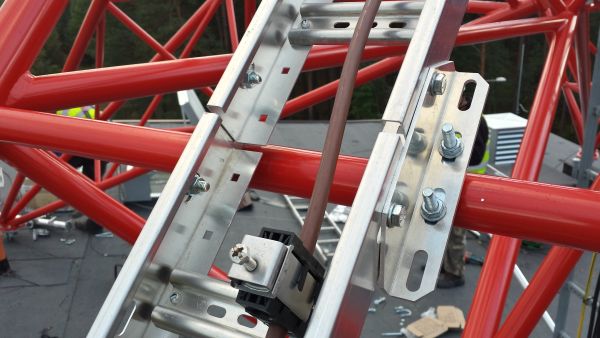There are three main issues to consider when dealing with lightning protection from telecommunications masts.
- Method of removing load from the mast after a lightning strike
- A method of discharging the charge induced in the mast structure as a result of the potential difference between the top of the structure and its base
- A method of dispersing charge in the ground
In our opinion, the best and cheapest way to dissipate the electric charge is to use a mast or truss tower structure. Alupro solutions are equipped with a special eye in the lowest segment that allows the entire unit to be connected to the building's lightning protection system. In the case of painted structures, remember to remove the paint coating on the segment flanges to maintain the electrical connection between them.
Another version assumes running an 8mm lightning rod to the top of the structure, which is then connected to the lightning rod (standard equipment of all AluPro masts). In our opinion, the lightning rod holders should be isolated from the truss structure in this arrangement, but metal mounts are often attached directly to the mast.
Radio operators often require the installation of a zeroing cable (usually LY50). Its role is to locally (every few meters) equalize the potentials induced on the feeder cable to the potential level of the truss at the same height. The split of the neutralizing cable is attached with the eye under the screw of the segment flange. The photo above shows how to route the LY50 cable with an AluPro cable ladder.
The load is discharged into the soil basically using two techniques - through a "bandage", i.e. a galvanized steel flat bar of various dimensions, usually 30x4, placed in a trench about 1.5 meters deep. If for some reason it is not possible to perform a continuous excavation (cube, street, wall), you can use steel rods threaded at the top and bottom, nailed vertically and connected together using also threaded steel sleeves (long nuts). Such a system is colloquially called "galmar" after a quite popular company - the manufacturer of this solution. The rods come in 3-meter sections and are twisted to length according to: needs - usually 3 pieces, so that one jointed rod reaches approx. 9 meters deep. Experience shows that, depending on water conditions and soil type, it is necessary to kill from 3 to 18 glamars to obtain the standard installation resistance (max 10 ohm).
The squid killing technique is also used as a supplement to the already performed ring lightning removal with a cooperage. If the initial measurement of the bandage shows too high resistance, we supplement the system with rods.
The correct method of beating is regulated by the following standards:
- series of standards PN-EN 62305 (parts 1 – 4) Lightning protection,
- standard PN-IEC 60364–4–443:1999 Electrical installations in buildings – Protection against overvoltages – Protection against atmospheric or switching overvoltages,
- series of standards PN-EN 62561 (parts 1-7) Elements of a lightning protection device (LPSC),
- Act on Standardization, of 12 September 2002,
- and the Regulation of the Minister of Infrastructure on "Technical conditions to be met by buildings and their location" as amended.
The topic can be deepened by reading the text by Mr. Anrzej Sowa from the Białystok University of Technology

